|
DID
YOU KNOW.....
Historical, interesting and unusual photos of
Football Grounds
Football has a million
and one stories and just as many facts and figures. Here are a few of them
- the record-breaking, unusual and bizarre. More
Did You Knows...
Index
1 2
3 4
5 6 7
8 9
10 11
12 13
14 15
16 17
18 19
20
21
22 23
24 25
26 27
28 29
30 31
32 33
34
The latest Front Page Pictures
are
on the Home Page - but here are the ground
pictures from previous weeks.
Other photo pages - Players, managers &
fans - team groups.
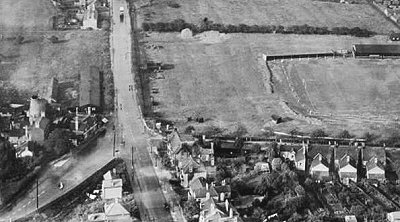
Peterborough United have been
talking about moving to a new ground for years now and that is beginning to
look more likely with a move to the town embankment on the cards. Their
current London Road ground has been their home since their formation in 1934
and before then the ground had been the home of Peterborough's other elite
clubs - first Peterborough City and then Peterborough & Fletton United.
This is one of my favourite pictures of the ground - from the 1930s - but
sadly the person taking the picture didn't have the foresight to realise
that one day there would be an internet and that pictures of football
grounds would be a popular thing to view on that internet. But although
ideally the picture would be further to the right it does show the main
structure at the ground - the stand - and to the right of that, I promise,
isn't an Old Trafford style structure but more of the same terraces. Posh
normally had a home crowd of 2-3000 in their early Midland League days
The road system is the same
now as in the photo with London Road and Fletton Avenue being the main roads
and Glebe Road being below the ground. The thing I find amazing about the
picture though is that it looks like the ground is situated in farmland! OK
it was the 1930s and although Peterborough has never been the biggest city
in the world it is a city with the London Road ground being one of the
closest to a city centre in the current Football League - just a few minutes
walk away at the top of the picture. Times have certainly changed!
* * * * *
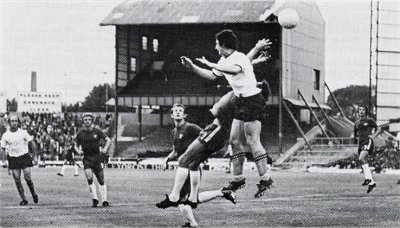
My last
visit to Stamford bridge was to see mighty Peterborough United beat Chelsea (OK
it was the Checkatrade Trophy!) and have to say that the ground has
changed a tad since this picture was taken in August 1974. The massive
East Stand had then just opened (you can just see the edge of it on the
right hand side) leaving the pictured North Stand as a bit of an unused
eye-saw. Half had been demolished and the bit left would soon go the same
way. Building work had begun on that North Stand just before the Second
World War had started in 1939 and was still unfinished when used for the
first time after the war had ended in 1945. Stamford Bridge was the home
of both football and greyhound racing at that time and that stand proved
to be a popular viewing area for the dogs - the greyhound authorities had
stumped up most of the £20,000 cost of the building work. The match
pictured was the First Division fixture between Chelsea and Burnley and
shows Paul Fletcher challenging Chelsea 'keeper Peter Bonetti. Chelsea
took a 3-0 lead but at the final whistle it was 3-3.
* * * * *
.jpg)
It's hard to believe that
Premier League football was being played on the site of this photo when I
posted this picture! The photo is of the original Craven Cottage.
Built in 1780 this Craven Cottage was destroyed by fire in May 1888.
Fulham took over the derelict site in 1894 and spent two years building a
new ground with their first match there being on 10th October 1896, a 4-0
Middlesex Senior Cup victory over Minerva. The pictured Craven Cottage was
situated near enough in what is now the centre circle of the Craven
Cottage stadium. You could almost imagine the person in the picture being
a ref!
* * * * *
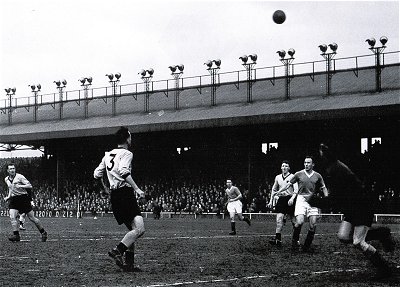
Hull City in action in their
Division 3 (North) match against Carlisle United in March 1958. It's a bit
before my time - I well remember the floodlights at their former
Boothferry Park ground but my memories are a tad later when they had six
huge floodlight pylons at least one of which was behind a stand. I'm
guessing they changed from one unusual floodlight set-up (pictured) to the
unusual array I remember when a stand was rebuilt. When would that have
been?
* * * * *
_-_Pele.jpg)
Well this is a sight we will
never see in England again - a massed bank of thousands of
supporters...watching a friendly would you believe! It was at Hillsborough
on February 23rd 1972 when Sheffield Wednesday entertained Santos of Brazil
who included in their ranks their star player, Pele. Amazingly the match
kicked off at 2.30 on a Wednesday afternoon as a miners strike had resulted
in power restrictions which prevented the use of floodlights. Even so the
attendance was 36,996 who most Sheffield schools having truancy problems on
that Wednesday! Santos - who had also played a friendly at Hillsborough ten
years earlier - won 2-0 with Wednesday player Tommy Craig sticking rigidly
to Pele in the last few minutes of the match - so that he could get the
great man's shirt at the final whistle!
* * * * *
.jpg)
Well, you
wouldn't see a picture like that in one of the newly built football
grounds would you. Watching a match from your own front garden would be an
impossibility in one of those and I'm guessing sitting on top of a
hut would break every health and safety rule known to man. The picture is
of the Goldstone Ground which was home to Brighton & Hove throughout their
League history until it was controversially closed and was sold in 1997.
Brighton then had to ground-share with Gillingham and play at the Withdean
Stadium in Brighton before finally getting a new home - the Amex Stadium -
in 2011. The picture was taken in the 1982/83 season, their final season
in their first stint in the top flight. They were in financial trouble and
found it hard to attract break-even crowds of 16,500 so over Christmas and
New Year they reduced their admission price from the normal £2.50 to £2
for the fixtures against Southampton (21,794), Watford (15,139) and
Nottingham Forest (10,402). Or you could have watched it from your garden!
* * * * *
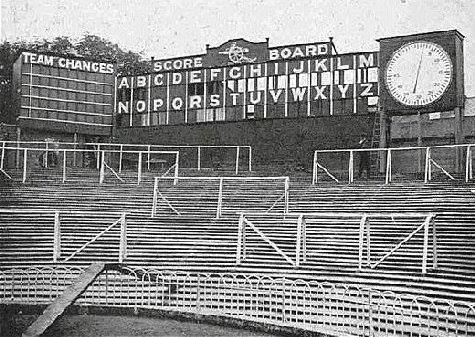
I was at a
live televised match the other day and I was surprised to see somebody
sitting near me watching the match on his device rather than what was
going on in front of him - and it wasn't as live as I thought it would be!
But I must admit the technology employed in football nowadays is light
years ahead of what was around when I was a tad younger with VAR being the
latest addition. Going right back to the 1930s though Arsenal were way
ahead of the others as far as innovation was concerned with their manager
Herbert Chapman being considered one of the great forward-thinkers in the
game. Their 'technology corner' of the period at Highbury is pictured. The
scoreboard idea will be familiar to many with the half-time scores - and
sometimes the full-time ones - being given although you did need to buy a
programme to get the code for the matches being played. I've seen team
changes on an electronic scoreboard but I'm guessing on Arsenal's manual
one that it was perhaps using players numbers from the programme again.
Can anyone help with that one? Its the clock that has become iconic at
Arsenal. It's the original clock pictured - that was a 45 minute
count-down clock but that had to be scraped as FA considered that it
undermined the match officials. A standard clock replaced it and the rest, as
they say, is what history is made of!
* * * * *
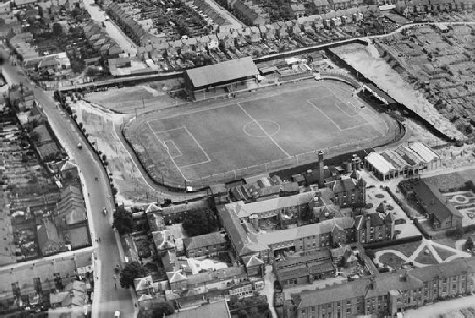
Following on from the
previous picture below this was the Vicarage Road Recreation Ground soon after
it had been transformed into Watford FCs Vicarage Road Ground. The picture
has been taken from a similar position although this time the famous
allotments are in view to the right. Watford played their first match at
the ground in 1922 with this picture being taken around 10 years after
that. As with most grounds of the era it was very much one for the
standing fan with stands - or indeed any covered area - being very absent.
Also absent is the penalty area 'D' marking on the pitch which wasn't
introduced until 1937.
* * * * *
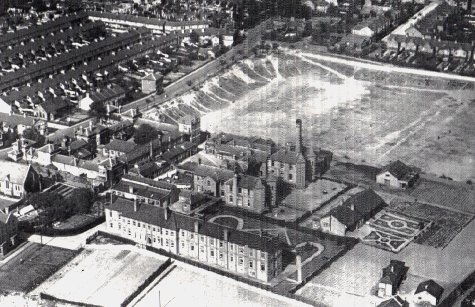
When Watford outgrew their
Cassio Road ground they moved to a new home on the site of the Vicarage
Road Recreation ground, pictured above. In proved a perfect site for the
new ground which was bordered by houses, an old Workhouse on the
site of a hospital and a steam laundry housed in a former silk mill. The
famous allotments are out of sight on the right hand side of the picture.
The slope on the left hand side of the site was well used by kids as a
slide - on sledges in the snow and tin trays at other times - and was
perfectly suited for the terracing which took its place when the ground
was constructed. The Vicarage Road ground was opened in a match against
Millwall on 30th August 1922.
* * * * *
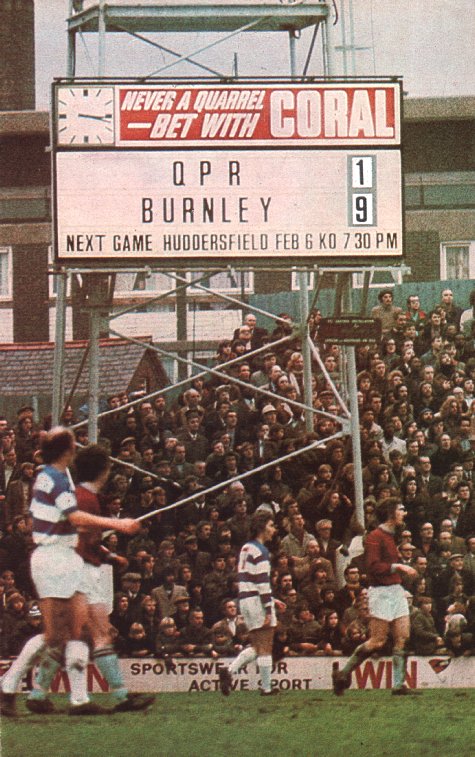
Long
before computers came along mistakes were still made on the scoreboards -
this one being at Loftus Road on 27th January 1973. Even the most
optimistic Burnley fan wouldn't have expected to be 9-1 up after a little
more than a quarter of an hour of the Saturday afternoon match. In fact it
was Queens Park Rangers who recorded a famous victory that day. Burnley
and QPR were red-hot favourites to win promotion from the Second Division
in 1972/73 with Burnley having lost just one of the 25 League matches they
had played up to the visit to London but QPR triumphed 2-0 in front of a
season-best 22,518 crowd at Loftus Road. Burnley and QPR filled the two
promotion spots at the seasons' end with Burnley taking the title by a
point. Aston Villa finished a distant third.
Links -
Division 2 table 1972/73,
Burnley results 1972/73,
QPR
results 1972/73
* * * * *
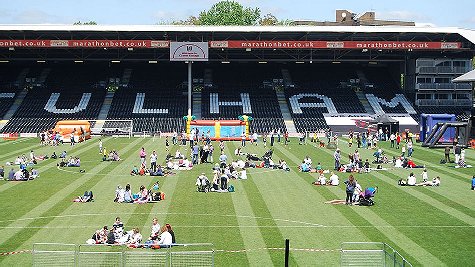
I did the tour of Craven Cottage once and
still remember the warning given - don't even think of stepping on the
pitch if you want to carry on living (well, something like that anyway!).
So I was surprised to see pictures of Fulham's first 'Picnic on the Pitch'
which took place at Craven Cottage in May 2015. OK it was after the season
had ended and was held to aid season tickets sales but people are walking
on the pitch and a tent has been erected on it!! I guess the ground-staff
were all the given time off to avoid the event or surely there would have
been palpitations all round that day. But a good idea I guess.
* * * * *
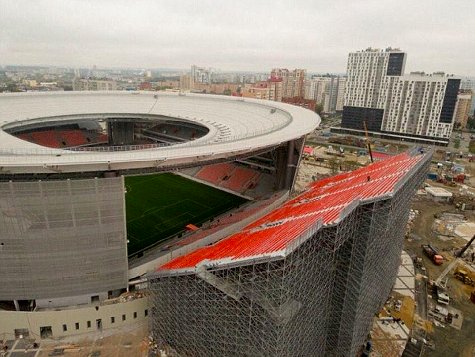
Well, I
think that I've seen it all now. I had thought that the Russians would
have had all the 2018 World Cup venues sorted to perfection but it seems
not quite. One of the venues used, the Ekaterinburg Arena which was the home of
Russian Premier League side FC Ural - had a normal capacity of 27,000 but
there was a 35,000 minimum requirement for matches in the World Cup finals.
So the ground had temporary stands erected to extend the capacity to
45.000 - but both of them were situated OUTSIDE the normal ground. Now
that's novel! I must say that it obviously didn't matter to those of us
who watched on television but the fans who parted with their
hard-earned to buy tickets might not have been too chuffed if their seats
were at
the back of those temporary stands, especially if it rained!
* * * * *
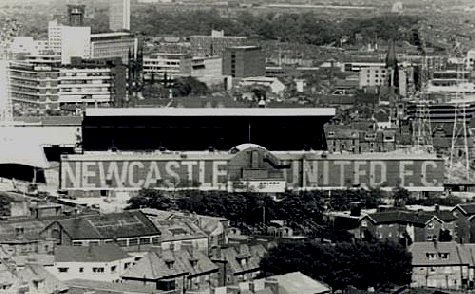
Well,
there was a time in the 1960s when if Newcastle United's fans forgot the
name of the club they supported they got a gentle 50 foot high reminder by
visiting the West End stand at St James' Parkl. Surely the biggest club
name banner in football?? The West End stand at Newcastle was opened in
1906 - it cost £8082 14s 11d - and for many years it was the only
stand at St James' Park with the other three three sides being vast open
terraces. It survived until the Valley Parade fire of 1985 when new safety
regulations saw it demolished and replaced by the Jackie Milburn Stand -
and that one cost over £5 million. The ultimate in comfort I guess - but
not the same in character!
* * * * *
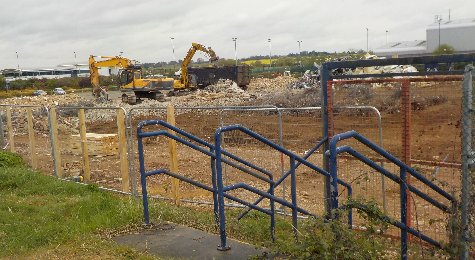
April
27th 2017 and the Airware Stand at the former Nene Park home of Rushden &
Diamonds is no more than a pile of rubble. The dream that was the smallest
town ever to host League football has now long gone. Sadly.
* * * * *
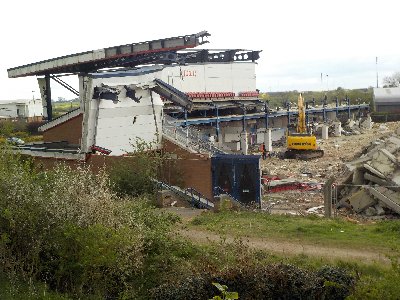
A week after
the picture below this is all that is left standing of the former
Nene Park home of Rushden & Diamonds. It's soon going to be just a pile of
rubble and memories!
* * * * *
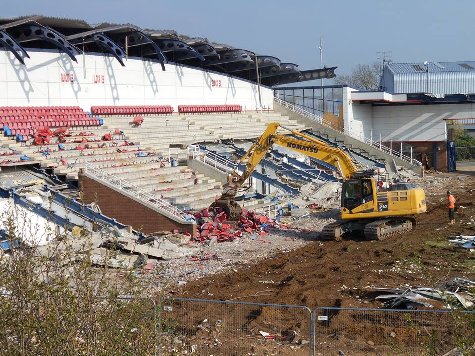
A picture On April 6th 2017 at the former Nene
Park home of Rushden & Diamonds. As the demolition progresses I'm getting
more annoyed. The Airware Stand is the last still standing but it won't be
for long, and even the seats are being destroyed - surely they could be
recycled somewhere? Its a new stand - and a fairly new ground - and many
lower division Football League sides would have been proud the have the
Airware as part of their ground. But its all going - a disgrace to
football and vandalism at its worst!
* * * * *
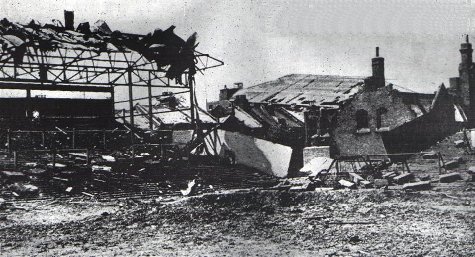
West Ham United's Upton Park - sorry Boleyn
Ground - after it had been hit by a flying bomb in August 1944. On the
left of the picture is the
South Bank, on the right is St John's Church and at the back is the Odeon
Cinema in the Barking Road. The ground was closed until 2nd December 1944 during
which time West Ham played 14 War League matches away from home
* * * * *
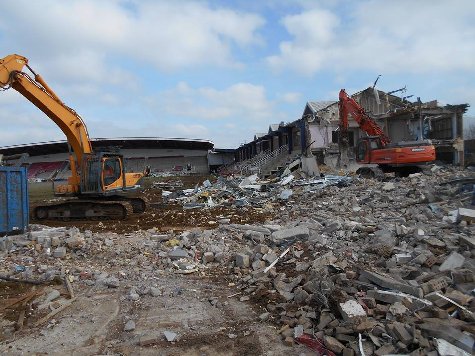
A picture taken at the end of March 2017 and soon
the former Nene Park ground of Rushden and Diamonds will be no more. An
absolute disgrace. Two decent non-league sides, Irthlingborough Diamonds
and Rushden Town were combined and then followed an amazing progression
until Rushden & Diamonds became a Football League side. Then the rich-man
owner walked away from that particular toy and the club found it impossible
to survive. OK, League football in Irthlingborough was never going to be
sustainable but for locals to lose that as well as the historic clubs and
the Nene Park ground that were the basis of that achievement is incredibly
sad!
* * * * *
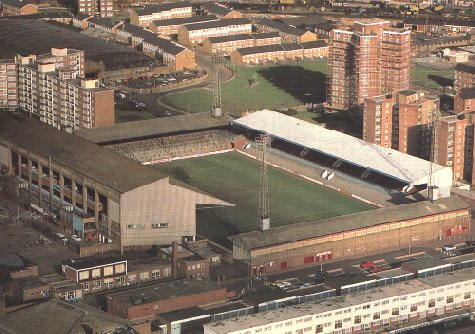
Upton
Park - or more correctly the Boleyn Ground - pictured in 1981. The home of West
Ham United for 112 years, the first match there was a Southern League fixture against Millwall on September 2nd 1904 and the last was that troubled Premier
League match against Manchester United on May 10th 2016. During that time the
Hammers played there 2398 times with their best crowd being 42,322 for a First
Division match against Spurs on October 17th 1970. The ground capacity had
reduced to around 35,000 by the time they moved to the Olympic Stadium.
* * * * *
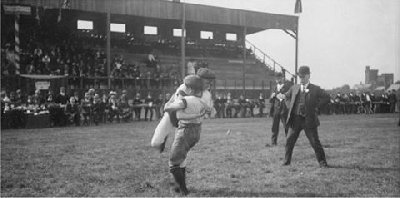
No not a 1910 goal celebration being
closely watched by a ref but Cumberland & Westmorland wrestling - whatever that might be - staged at Carlisle
United's Brunton Park ground in 1910, a year after the ground opened. That
wooden stand survived until 1953 when an electrical fault started a fire
which destroyed it.. The problem of having no stand at the ground was
solved later in the year when Carlisle transferred Geoff Twentyman to Liverpool - the transfer fee paid for a new, tad more
modern, stand.
* * * * *
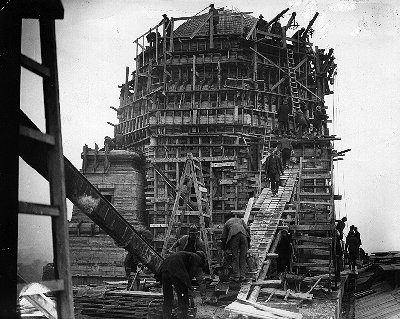
One of my favourite pictures of the
original Wembley Stadium being built - definitely before the days of
Health and Safety! The new national stadium was the centre-piece of the
site chosen for the 1924 British Empire Exhibition which was constructed
in parkland near Wembley which was then a little more than a village on
the edge of London. The stadium itself was built in only 300 working days
between January 1922 and April 1923. Some 150,000 tons of clay was removed
from the hill that occupied the site while 25,000 tons of concrete, 1,400
tons of steel and over half a million rivets were used in the stadiums'
construction. It was finished just days before the first match at the
ground - the 1923 FA Cup final between Bolton and West Ham - when around
300,000 turned up for the only Wembley FA Cup final that was not
all-ticket. Around 200,000 got in, although the official attendance was a
record 126,047, to see Bolton win 2-0. Fast forward then to 2003 when
those twin towers were demolished - I still think that was an act of
totally vandalism!
* * * * *
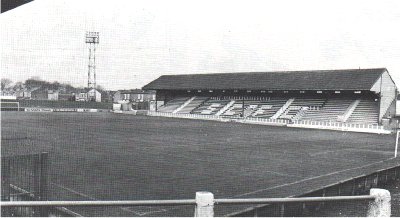
A picture pinched from the front cover
of the Stockport County programme of 1986/87...so I'm taking a wild guess
that it's Edgeley Park in 1986/87! Grounds staging both football and rugby
matches are common now but when Stockport first played there in 1902 (at
the start of their third season in the League) they shared it with the
Stockport rugby team who had been there since 1891. But by 1903 the rugby
club had gone bust leaving County in sole charge of the ground. County
have been there ever since - they have played in the second tier of the
League, set a record attendance of 27,833 for an FA Cup match against
Liverpool in 1950, made regular trips to Wembley and even had George Best
playing for them at the ground. Sadly in more recent years Stockport
County have dropped down to non-league football and had to sell the all-seater
ground to the local council to prevent the land being used for housing.
Fingers crossed, their fortunes will improve soon.
* * * * *
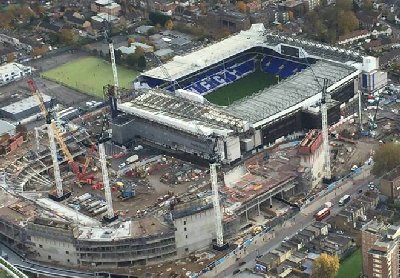
An
interesting picture of the development of Tottenham's new
61,000 capacity ground which opened for Premier League football in April
2019. It clearly shows what was the imminent need to demolish the White Hart Lane ground that
had been their home
since 1899. Despite the disappointment of their Champions League campaign
at Wembley in 2016 the national stadium staged all their home matches in
2017/18 and most of the following season. The 85,512
Wembley attendance for the Spurs v Bayer Leverkusen Champions League group
match in November 2016 was the highest ever attendance for any 'home' match for an
English club side. That crowd just beat the attendance earlier that season
against Monaco at Wembley with the previous English best being 84,569 at Maine Road for a Manchester City v Stoke FA
Cup tie in 1934. The
best at the old White Hart Lane ground was 75,038 for an FA Cup tie against Sunderland in
1938.
* * * * *
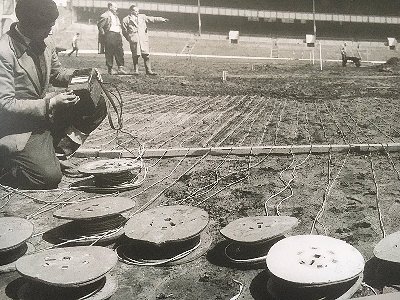
A
picture of what was state-of-the-art pitch preparation back in 1958. No,
not a system to give an electric shock to the ref every time he got a
decision wrong but the first undersoil heating system which was installed
at Everton's Goodison Park ground in the summer of 1958 to combat the
serious problem of frozen pitches causing abandonments and postponements.
Around 20 miles of electric heating wires costing around £16,000 were laid
a few inches below the surface. Funnily enough it proved too successful -
there was so much melt-water that the drainage system couldn't cope and
two years later the pitch had to be dug up again to install an improved
drainage system!
* * * * *
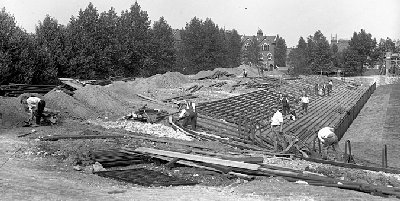
It looks very leisurely
but this is the North Bank of Arsenal's Highbury Stadium being constructed
in 1913, just before the ground opened. When Arsenal - then Woolwich Arsenal - moved from Plumstead to Islington it was controversial
and it saw
the same criticism as would later happen with Wimbledon's move to Milton
Keynes.
Their fans weren't chuffed (they averaged around 8000 at their last season
at the Manor Ground), the near-by existing clubs - Spurs and Clapton (now
Leyton) Orient - both
protested as did the local council and residents. The site for the ground
- then nothing more
than playing fields - belonged to the Church and it was the Archbishop of
Canterbury who signed the first lease agreement. In that agreement Arsenal were prevented
playing on Sundays, Christmas Day or Good Friday with alcohol and gambling
both being banned. Things have changed! Just six months after the
agreement was signed the Woolwich Arsenal, as they still were, played
their first League match at Highbury which was little more than a building
site with the only stand - the East Stand - still just a shell. But 20,000
turned up at that first match...and a few more were to follow in years to
come.
* * * * *
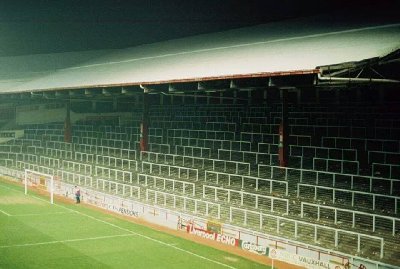
The new stand at Liverpool
is an impressive building but it will surely never match the iconic status that was given to a former part of the Anfield ground
....the Kop. Unveiled in1906 the huge embankment on the south side of the ground was originally
known as the Oakfield Road bank but was soon renamed the 'Spion Kop' after the site of
a famous and bloody battle in the Boer War. It was one of the highest embankments in
English football with the uncovered terracing having the reputation of
being bitterly cold in winter although the Kopites
gained a degree of comfort when a roof was added in 1928. In its heyday the
Kop accommodated around 30,000 standing fans but that figured had been
halved by the time of its closure.
The Taylor report which followed the Hillsborough disaster brought
standing in the top divisions
to an end and the final match for the standing Kop came on Saturday 30th
April 1994 when
Norwich gained a 1-0 Premier League victory.
* * * * *
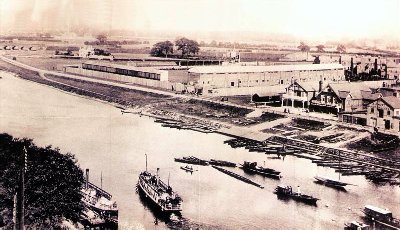
One of
my favourite pictures of the City Ground home of Nottingham Forest taken
in the year it opened, 1898. It looks a very basic ground which was partly
due to the fact that the club was
run by a committee and so money was tight. Crowds were also a bit more
sparse in those days.
The first match there was a Division 1 fixture against Blackburn Rovers on
the opening
day of the 1898/99 season, September 3rd 1898, when 15,000 were present to
see the visitors
win 1-0. Only the local derby against Notts County had a better crowd that
season at
the
City Ground, 16,000, but the top crowd of that campaign was for the return
match at Notts County, 20,000.
Several of Forest's home League matches saw crowds of just 3,000 present,
including
their match against Liverpool (things would change!). County were better
supported that season,
and finished above Forest in the First Division table! If the modern
Cloughie stand could be superimposed on that picture it would dominate the
whole area!
* * * * *
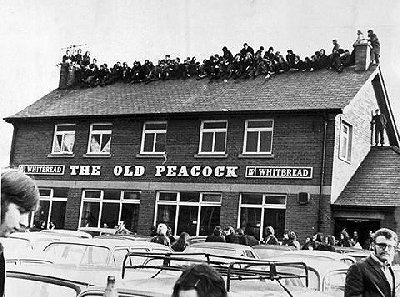
Pubs and football grounds seem to go together very well, although not
usually as a perch to watch a match from! The Old Peacock Pub is next to
the Elland Road home of Leeds United and is pictured in 1972 - health and
safety hadn't been invented then! Leeds were involved in one of the
closest finishes to a top flight season. Derby won the title finishing a
point ahead of Leeds (2nd), Liverpool and Manchester City (1971/72
League table & results). This picture though was taken at an FA Cup
4th round replay with Liverpool which had kicked off at 2.30 on a
Wednesday afternoon in February. The reason? The miners were on strike and
in those days no coal meant no electricity and so floodlights couldn't be
used. Not that the unusual timing did much to keep the fans away with the
attendance of 45,821 - plus the ones on the roof - being Elland Road's
third best crowd of the season.
* * * * *
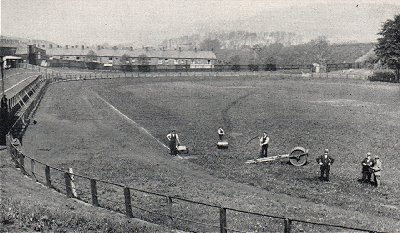
Bolton
Wanderers played their first match at the pictured Pikes Lane ground in
1880 but it was on September 8th 1888 that the ground won its place in football
history. On that day it was one of five grounds that hosted the first ever Football
League matches - Bolton lost 3-6 to Derby County in front of 5000 spectators.
The
formation of the Football League. There was a grandstand along one
side but the most popular viewing point was from a hill next to one of the other
touchlines on which assembled up to 4000 fans. It wasn't the most popular of grounds
with poor facilities and a pitch which soon turned into a mud-bath but its
end came after the landlords upped the rent from £35 - a year! - in 1888 to £175
five years later. Bolton played their last match at Pikes Lane in 1895 and then moved to
Burnden Park. The ground was sold for building - in those pre-Ikea and Tesco days just
ordinary houses were built on the site!
* * * * *
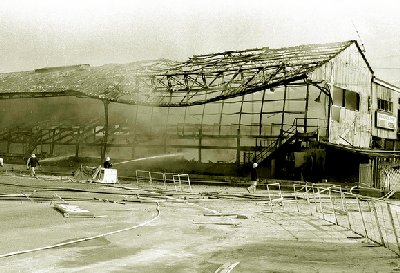
Bristol
Rovers former Eastville Stadium home was probably best remembered by most
for the
flower beds behind the goals and the aroma from the local gas works. A
more tragic memory
would be of the fire that destroyed the South Stand in August 1980
following the first Division 3 match of the season, against Orient. Rovers
were then forced to play their next five League and
Cup matches on 'enemy' territory - Ashton Gate. Their final match at
Eastville was in April 1986
with Rovers then moving to share Bath City City's Twerton Park ground
before arriving at the
Memorial Ground. Eastville is now the site of an IKEA store.
* * * * *
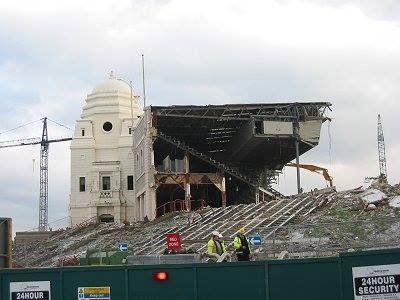
The old
Wembley in 2003 in its last days. It still think that within the £800
million or so it cost to build the new stadium a few bob could have been found to
incorporate those towers
into the new building or move them somewhere else. To me it was vandalism
at its worst when
they were demolished. As I turned round and walked away after taking the
photo there was a
clap of thunder - in January! That just about summed up what I thought.
Anyway the old
ground was with us from 1923 to 2000 which the new ground staging its
first matches in 2007.
* * * * *
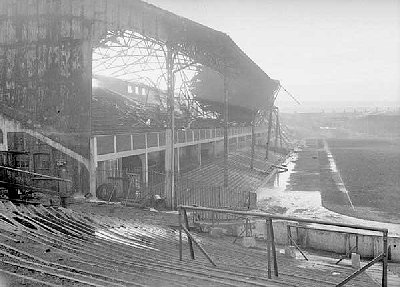
Fires in wooden stands were once not uncommon although thankfully never
with the tragic consequences of the Valley Parade disaster. On April 3rd
1950 a fire in the West Stand
of the former Leeds Road home of Huddersfield Town destroyed most of the
upper tier and roof.
The club were forced to play their next two matches at the Elland Road
home of Leeds United and ironically in the second of those matches -
against Newcastle United - the 37,766 crowd was their best 'home' attendance of the
season. The stand was rebuilt during the summer and re-opened
at the start of the 1950/51 season. Huddersfield played their last League
match at Leeds Road
on 30th April 1994 against Blackpool before their move to the Alfred
McAlpine Stadium.
* * * * *
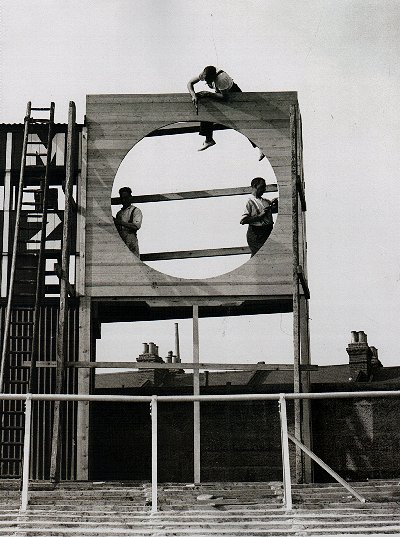
One
of the iconic sights at a football ground over the years was the clock at
Arsenal's former
home at Highbury. An idea of Arsenal's innovative manager at the time -
Herbert Chapman - the
first of many clocks counted down the 45 minutes of each half but it was
changed to a
standard clock after criticism that the 'countdown' undermined the match
officials. Pictured are workers installing the clock in the 1930s - it was
originally positioned on the north side of the ground but moved to its
traditional home on the south side, the 'Clock End', when the north
bank
was developed.
* * * * *
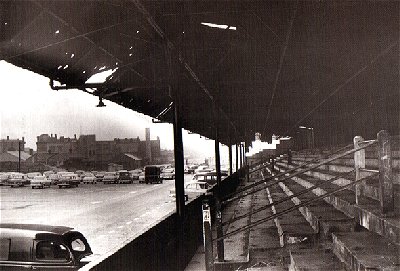
If
you have every been at match and thought it would be more entertaining
watching the cars park
in the car park you once could have done just that at a former home of
Port Vale. Vale played their
last match at the Old Recreation Ground on 22nd April 1950 - Aldershot won
1-0 - and the pitch
was rapidly turned into a car park. A car park it remained until the 1980s
when it
became the inevitable shopping centre.
* * * * *
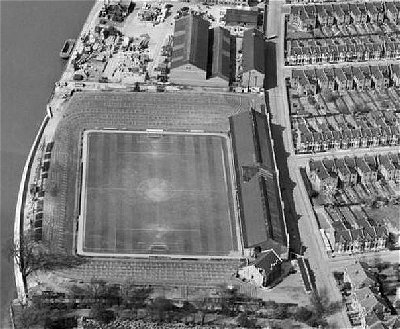
Fulham's Craven Cottage ground in the late 1940's. Just the one stand with
the Craven Cottage itself in the bottom right-hand corner. All four sides now have
covered stands but in those days
the open terraces saw a record attendance at the ground of 49,335 against
Millwall in 1938.
On boat race day the riverside terracing also proved to be the perfect
viewing point for anyone not totally absorbed by the game of football on
offer! The whole area looks neat and tidy with not a car
or television aerial - or a person - in sight.
* * * * * *
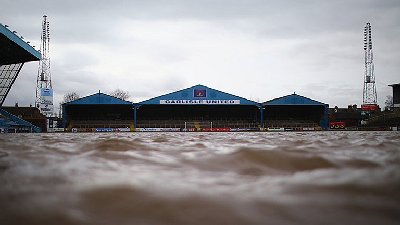
Whatever you think about the global warming debate there can be no
argument that the winter months of 2015/16 saw some extreme weather
conditions with tragic consequences in
various parts of the country. As far as League football was concerned Brunton Park
in what became Carlisle-on-Sea was the worst hit. Flooding at the
ground is not unknown but on this occasion the club was exiled from their home
ground to Preston, Blackburn and Blackpool (results), the pitch having to be
relayed and considerable
damage to the club buildings being repaired.
* * * * * *
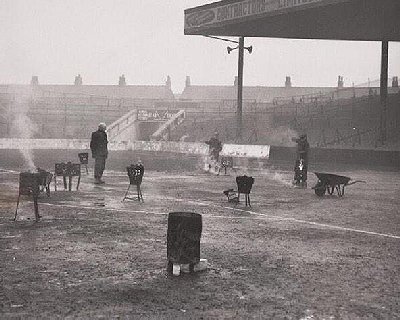
In days gone by, before undersoil heating became the
norm, even the top grounds in the country had pitches that looked more like ploughed fields
rather than the
snooker-table finish we now expect. Pictured is the Maine Road ground of
Manchester City
and the treatment it was getting to make it playable for the FA Cup tie
against Swindon Town on January 10th 1953. The match was played - and City
won 7-0!
Link - Postponed matches
* * * * * *
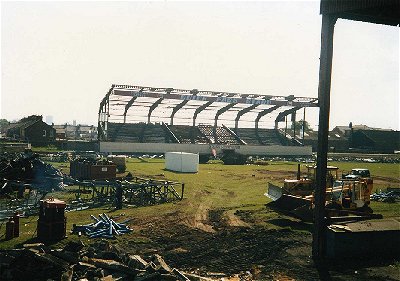
A piece of footballing
history being demolished. Following their move to Glanford Park in 1988
Scunthorpe's former home at the Old Show Ground was demolished -
inevitably to make way for a supermarket! Although they had hoped to
dismantle the pictured stand and move it to
Glanford Park that idea had to be abandoned because of the cost. When it
was built it was
the first cantilever stand - a stand with no supporting pillars to block
the view - at a British football ground. A local steel company had built
it for them on favourable terms hoping that it would be a showcase for
other clubs. The stand was officially opened on 23rd August 1958 with
Glanford Park staging its last match on 18th May 1988.
* * * * * *
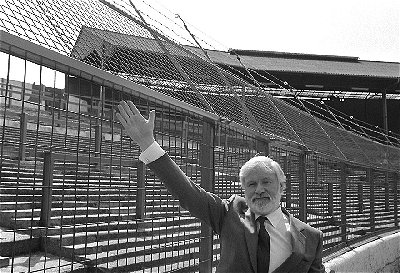
Back in the 1980's Chelsea weren't alone in suffering crowd problems but
their response to an FA warning after a pitch invasion during a League Cup
semi against Sunderland at Stamford Bridge in March 1985 was both unique
and shocking. Controversial chairman Ken Bates had a 12-foot high
electrified fence built around the pitch which was due to be switched on
for a First Division match against Tottenham on Saturday April 27th 1985.
Football supporters everywhere were outraged and
just 3 days before the proposed switch-on the Greater London Council
threatened High Court
action - believing there to have been a breach of safety and planning
rules - unless
Chelsea abandoned their intention of allowing the 12-volts to flow. The
match against Spurs was planned to be a celebration of their 80th
anniversary of first playing at Stamford Bridge but all the headlines were
about that fence. The match ended 1-1 and the electricity wasn't switched
on -
and never was.
* * * * * *
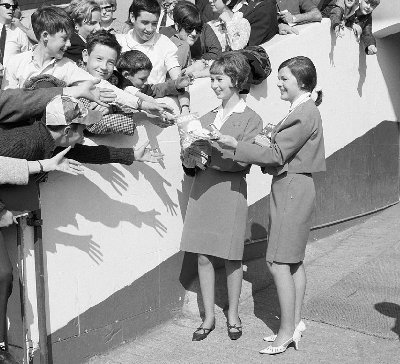
Well, the previous picture below was how they sold the match-day programme
up't north in the old days while in contrast this picture shows how they
were sold in the south in the swinging sixties. A picture from Stamford
Bridge in 1966. I just have a feeling that buying a programme was more
part of the routine at Chelsea than at Darlington?
Or not!
* * * * * *
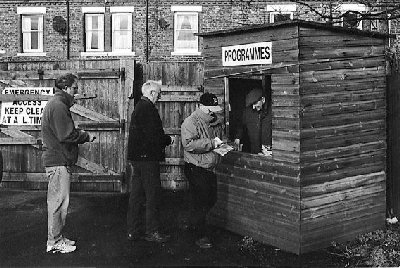
Now that's what programmes were all about! Buying a 3d programme from the
bloke in the hut was an important part of a match-day routine, you just
needed one to make the match-day experience complete!. That programme that had about 20 pages and
wasn't what we get now - a small booklet that weighs a ton, costs a
fortune, doesn't fit in any pocket and contains no more information - buts
loads more adverts - than those 3d publications. The programme hut at the
old Feethams home of Darlington - but a bit more recent than when
programmes cost 3d I think!
* * * * * *
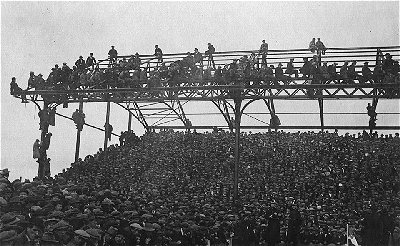
Cardiff City v Chelsea at Ninian Park in March 1921. Over 45,000 were
assembled for an FA Cup
4th Round tie with every conceivable vantage point being taken. No way
would that be acceptable now - Health and Safety would see that match
abandoned...and to be fair I wouldn't fancy standing below that lot on the
roof! Cardiff won 1-0.
* * * * * *
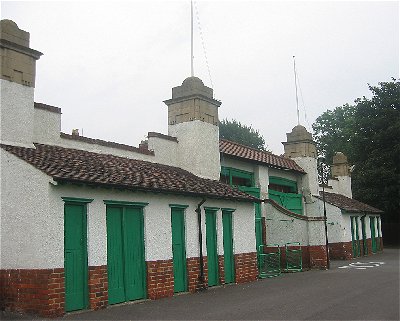
I
still think that the demolition of the Twin Towers at Wembley was an act
of total vandalism - surely there was enough money around in football to
take them down and rebuild them as part of the new Wembley. But at least
that left the Twin Towers of Darlington with the entrance to the old
Feethams football ground/cricket ground having a passing resemblance to
the Twin Towers of Wembley - providing you've got a good imagination that
is! Sadly even they went. After Darlington left the Feethams for the Arena
(what a disaster!) in 2013 the towers where taken down down and rebuilt
nearby to make way for a housing development on the old ground. But - of
course - they don't look anything like the days when thousands of fans
passed through them on the way to a match.
* * * * * *
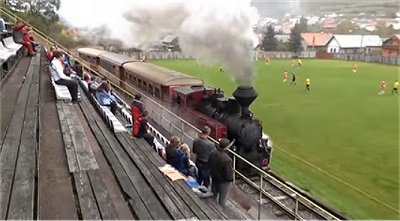
There are a few British grounds with a railway line just outside their
ground but none withone inside the ground. I don't think the health and safety rules would
allow it! But Slovakian
amateur side TJ Tatran Čierny
Balog have a ground with a railway line between the pitch and the stand.
Really - unique or what? And I guess rather than be able to park the
proverbial bus in
front of the goal if they could build a siding they could park a train
between their goal
and the opposing forward line!
* * * * * *
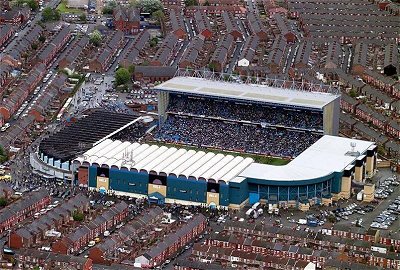
A brilliant picture of Maine Road, the home ground of Manchester City
between 1923 and 2003. In 1934 it hosted the highest attendance at a
League ground in England - 84,569 for an FA Cup quarter final against
Stoke City although 'technically' that record has now been bettered by
Spurs when they played their 'home' matches at Wembley!. It clearly shows the different styles of the stands built over
the years and the lack of space round the ground. Whether you are a fan or
not of the new grounds like their current Etihad home they generally have
enough space around them to swing a cat!
* * * * * *
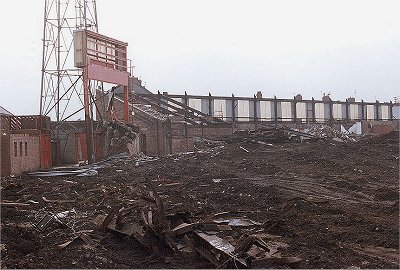
Well, I never stood at the Roker End for a match but I did stand there
when Roker Park was being demolished. Sunderland's first match at their old ground was on
10th September 1898 when 30,000 were present for First Division match
against Liverpool. The record crowd at Roker
was for an FA Cup tie against Derby County on 8th March 1933 when 75,118
were present but by the time the ground was demolished capacity had been
cut to less than half that figure. Liverpool provided the opposition for
the last match at Roker, a friendly on 13th May 1997 -
almost 99 years after that first match at the ground.
* * * * * *
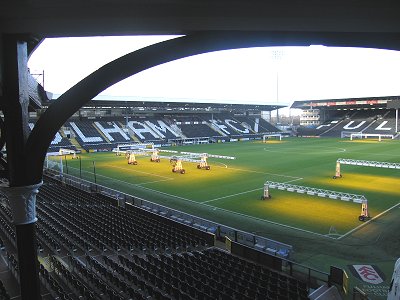
I've always wanted to watch a match from the Cottage at Craven Cottage.
The closest I have got though was watching the pitch getting a sun-tan!
With
undersoil heating and artificial sun to
get the grass growing the science of pitch maintenance has moved a long
way from the picture below -
bales of hay at White Hart Lane in the 1920s!
* * * * * *
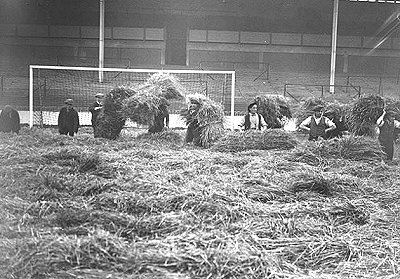
Premier League matches are occasionally postponed because of freezing
weather when the car parks become dangerous or the water pipes are frozen (so no
toilets!) but postponed because of a frozen pitch? No way - nowadays you just press a
button to switch the undersoil heating on. But back in the 1920s the state
of the art method of preventing
a frozen pitch was...straw! A picture of White Hart Lane on a day when
hundreds of
bales of straw were put on the pitch to keep the frost at bay. And then it
all had to be
taken off again not long before the match was played. Amazing.
* * * * * *
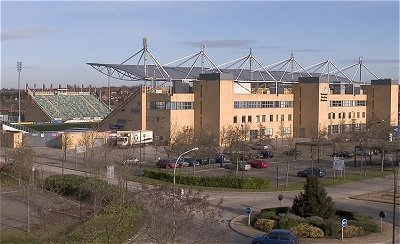
When Wimbledon first upped sticks and moved from London to Milton Keynes their first
home was the National Hockey Stadium, picture above with one of the town's
famous roundabouts. Wimbledon played their first home League match there on
September 27th 2003, a 2-2 draw with Burnley. They remained Wimbledon for
that season
before becoming Milton Keynes Dons. MK Dons moved to the newly-built
Stadium mk at the
start of the 2007/08 season.
The National Hockey Stadium has since been
demolished.
* * * * * *
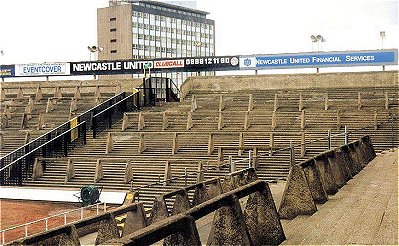
OK, this isn't
the best-known of architectural awards but my prize for the most
substantial bits of
masonry at a football ground goes to Newcastle United and
their old crowd
barriers. Those were
some hefty structures at St James' Park
but along with so much more they
have disappeared to make way for the modern all-seater ground.
* * * * * *
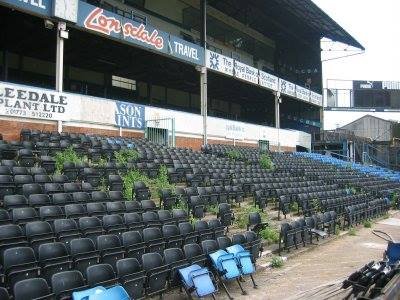
An image of Derby County's
Baseball Ground taken after the last match played there - a youth fixture
against Newcastle in 2003. Pride Park had been opened in 1997 with the
Baseball Ground then being
used for reserve and youth matches and so wasn't in the best state of
repair at the time.
But the memories - Cloughie, Real Madrid, Steve Bloomer, Juventus, Kevin
Hector, Benfica, Peter Shilton.......you never lose those memories!
* * * * * *
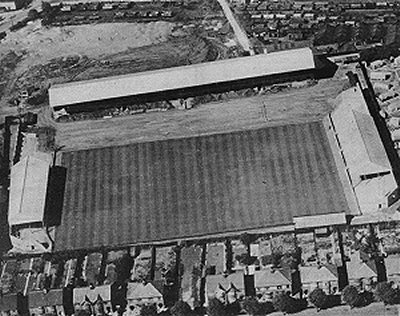
A picture
of Peterborough United's London Road ground during its transformation in
the late 1950s. What is still the club's Main Stand had just been built
behind the old stand which was then demolished (the point at which the
picture was taken) The pitch was then moved over towards the Main Stand
leaving space the other side where the Glebe Road terraces were
constructed (later replaced by the family stand). Amazingly this was all
done when Posh played in the Midland League although attendances in those
days regularly topped 10,000.
* * * * * *
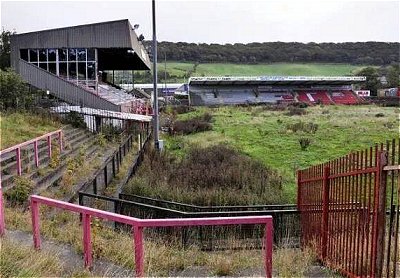
Whatever
club you support there can be fewer sadder sights in football than a
derelict football ground awaiting demolition. The memories are being
betrayed I guess. Scarborough FC were founded in 1879 and spent 12 seasons in the Football League
from
1987/88. Scarborough
first used their Seamer Road ground - later called the McCain Stadium - in
1898 and it
remained their home until they went bust in 2007. The ground then fell
into disrepair
until demolished in 2011.
* * * * * *
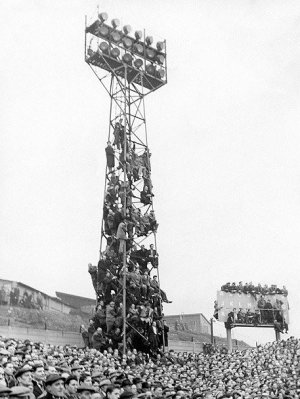
Who said people preferred to
stand up in the good old days! Long before Health and Safety was invented
these fans amongst a 45,646 crowd at the Den in January 1957 found a more
comfortable way to watch the FA Cup 4th Round tie. The original Den was
opened in
1910 when Millwall were still in the Southern League. Their last Football
League match there was against Bristol Rovers on 8th May 1993. The floodlights were first
used - for their
proper purpose that is - in a friendly against Manchester United
on 5th
October 1953.
* * * * * *
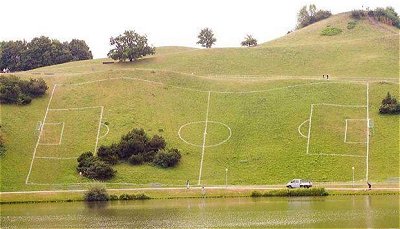
Yeovil Town's old Huish
Ground famously had a side-to-side slope of around 8 feet but I'm guessing that this one is a tad steeper. But it's surely got to be a
must on every Groundhoppers list!
* * * * * *
.jpg)
Following the final game of cricket at Sheffield United's Bramall Lane
ground in 1973 the last ground to host both Football
League and County Championship matches was the County Ground at
Northampton. Originally a cricket ground, Northampton Town were
residents of the County Ground from their formation in 1897. The picture
was taken in the
mid 1960s at about the time the Cobblers played their only season in the
old First Division (1965/66). The football
pitch had the reputation of having the worst playing surface in the League
which was largely the result of the pitch being used as a spectator area/car park/picnic area during the cricket season, as shown in the
picture. The Cobblers
played
their last match there on Tuesday October 11th 1994, a 0-1 Division 3
defeat by
Mansfield Town. Four days later they drew 1-1 with Barnet in their
first match at the Sixfields Stadium.
* * * * * *
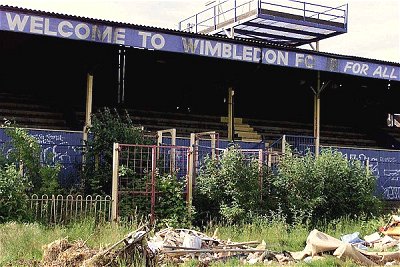
It's hard
to believe that the pictured ground hosted the likes of Arsenal, Liverpool
and Manchester United in League matches until the early 1990s.
Plough Lane had been the home of Wimbledon from 1912 with the ground first
hosting Football League football when Southern League Wimbledon were
elected
to the competition in 1977. Amazingly by their tenth season in the
competition Wimbledon were in the top division and in their 11th season
they won
the FA Cup! The club played their last League match at Plough Lane
against Crystal Palace on May 4th 1991 before moving to a groundshare at
Selhurst Park and eventually to Milton Keynes. Plough Lane was used until
1998
as the home for the reserve teams of Wimbledon and Crystal Palace
but was demolished in 2002 and later became a housing estate.
* * * * * *
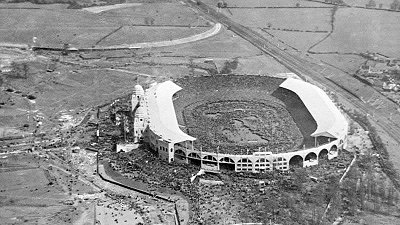
Wembley, Saturday April 28th
1923. The first match at the stadium, the
FA Cup final between
Bolton and West Ham. The official attendance
was 126,047 but perhaps
200,000 got
into the ground - it was the last FA Cup final
not to be all-ticket. What
I find amazing
about the picture is that London is missing, Wembley appears to be in the
middle of a field!
Things have certainly changed over the past 90 years or so.
* * * * * *
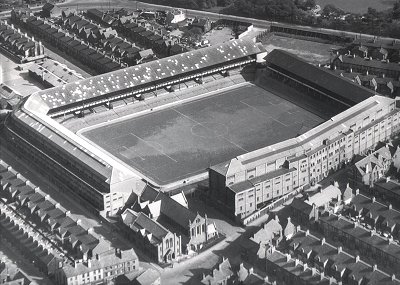
Over the years football clubs have shared their grounds with some unusual
neighbours.
Probably the best example of that is at Everton's Goodison Park ground.
When Everton
played their first match at Goodison in 1892 there was a church in the
corner of the ground and
St Luke's Church is still very much there and has become an important part
of of the Everton scene.
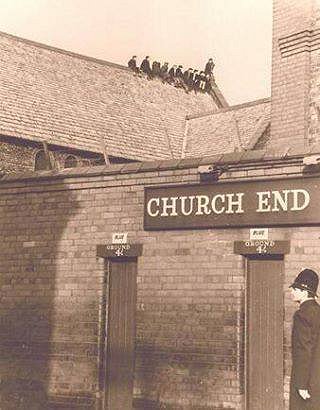
In recent years the church premises
at the corner of Goodison
have been used to dispense refreshments to the masses but in years gone by
the roof of
the church was used by spectators to watch the match. I'm not sure when
that was -
4 bob (20p) to get in so it had to be years before there were any thoughts
of Health & Safety!
* * * * * *
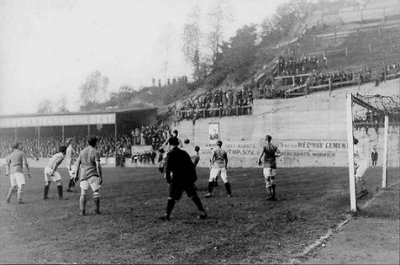
Probably the most
unusual ground to stage Football League matches was The Nest, Norwich
City’s home ground before they moved to Carrow Road. The Canaries had
their home at The Nest
from 1908, when they were in the Southern League, to 1935 by when they had
progressed to the Second Division of the Football League. What made it unusual was that it was built in the
bottom of a chalk pit with one end of the ground being next to the quarry
cliff which had a
retaining wall some 50 feet high and just a few feet from the touchline –
and there were
terraces for spectators at the top of it! It was dangerous for the players
and precarious for
the fans and once a barrier did give way (without any injuries) while on
another occasion part
of the pitch dropped 25 feet when there was movement in the old chalk
workings. For safety
reasons Norwich had to move and they signed a lease on a sports ground in
Carrow Road in June 1935 and transformed it into a ground which hosted
29,779 fans for a Second Division match
against West Ham United just 82 days later.
* * * * * *
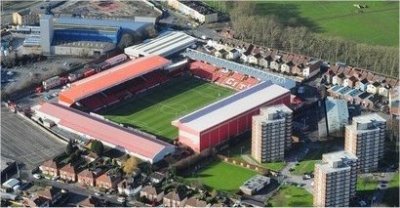
You couldn't get much more East End than 'Only
Fools and Horses', the long running
TV comedy series which starred David Jason as Del Boy. But in reality the
home of the
Trotters wasn't in Peckham but far away in...Bristol! The building which
doubled as their
Nelson Mandela House home was in fact a tower-block which overlooked the
Bristol City
ground with much of the filming taking place around the Ashton Gate
stadium.
Sorry if that shatters your illusions!
Link -
Bristol City
* * * * * *
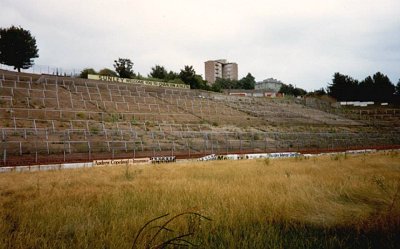
A picture of The Valley home
of Charlton Athletic showing the vast terracing
which at one
time saw the ground as the largest League ground in Europe. On
12th
February 1938
a ground record crowd of 75,031 saw Charlton entertain
Aston Villa in the
FA Cup although the
modern Valley has a capacity of a tad over 27,000. Between 1985 and 1992 -
when this picture was taken - money
problems meant that they had to
leave their
home and groundshare with
Crystal Palace and West Ham United.
Link
- Charlton Athletic
* * * * * *
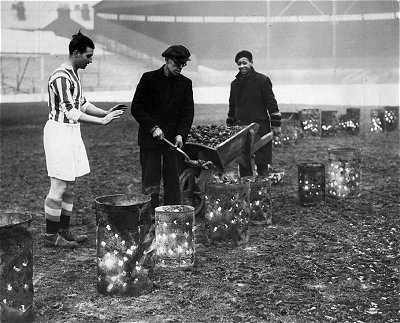
Well, it's turned chillier
recently but with global warming I doubt if we are going to experience
the winter we had in the 1962/63 season. The 'big freeze' hit the country
just before
Christmas 1962 and then followed hundreds of postponements and
abandoned
matches
before the next full programme was played in the Football League - on
March 16th 1963.
Before the days of undersoil heating clubs tried many different ideas to
thaw
the pitches,
including using flame-throwers at Blackpool and braziers at
Stoke City's
Victoria
Ground (pictured). You can't imagine Stoke's maestro Stanley Matthews
playing on a
pitch like that!
Link - Postponed
Matches
* * * * * *
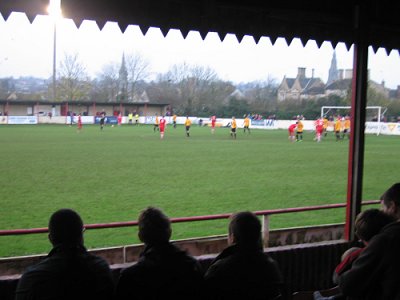
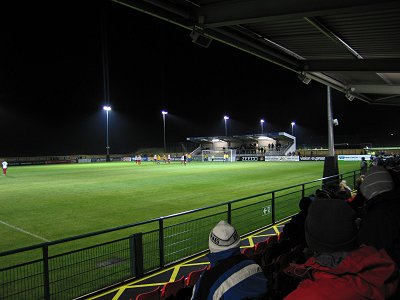
Well it
was all-change at Northern Premier League Stamford at the start of the
2014/15 season. Saturday
November 22nd 2014 saw the Daniels play their last match at Wothorpe Road
after 118 years in residence (top picture). On Friday December 5th the
first match was played at their new Zeeco Stadium - a friendly between the
Stamford Youth side and their counterparts from Blackstone (bottom
picture). Certainly a major change! The worst moan seemed to come from the St
Johns Ambulance man - he had no ice. Ironic really - the temperature felt
like about minus 20! Love it or hate it - now that's a matter of opinion!
* * * * * *
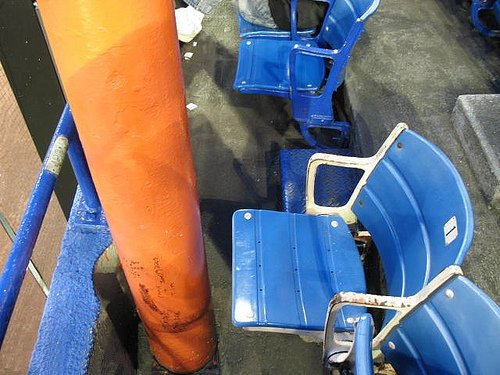
I sat in the old stand at Peterborough the
other day - not my favourite stand and although they were new seats they were still a bit 'cosy'. Or should I say no leg room
(or arm room)! But they were
nothing to compare with the picture above. I don't know if it is a
'naughty' seat for a fan who misbehaves but there seems little other point
in having it. I don't know where the picture was
taken but if this is what is meant by a restricted view seat I think I
would always pay the extra!
* * * * * *
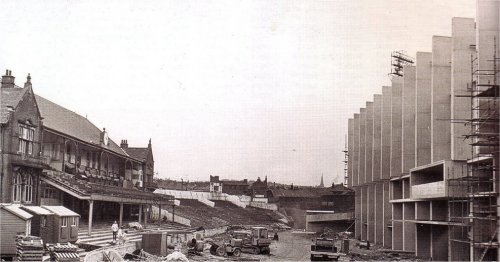
Sheffield United was
formed by Yorkshire Cricket Club in March 1889 just six days after
Bramall
Lane had staged an FA Cup semi-final which had taken £600 in receipts -
the
cricket club decided that regular football at the ground would prove
successful
(Bramall Lane).
It did prove successful, so
much so
that the football club became the senior partner and
eventually evicted
the cricket club from the ground. Yorkshire played their last County match
at Bramall Lane in August 1973, drawing with Leicestershire. The South
Stand at Bramall Lane was then built on part of the former cricket ground,
finally enclosing the football ground
on all four sides. Pictured above is the building of the South Stand with
the
cricket pavilion later being demolished to make way for a car park.
* * * * * *
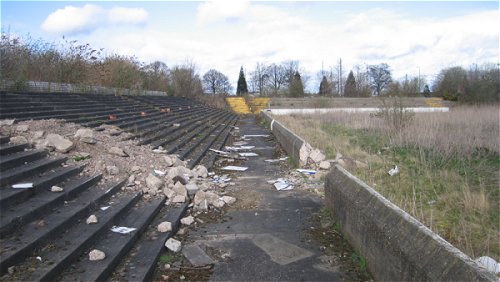
A picture taken in
2014 of what is left of Belle Vue, the former home of Doncaster Rovers.
In its time the pitch was considered one of the best playing surfaces in
the country, but no more. Since Donny last played there in 2006 before
their move to the Keepmoat all the stands have
gone leaving just a shell of terraces and pitch. An eerie scene and a long
way from the time in
1948 when a record crowd of 37,099 saw them play Hull City at the ground.
|